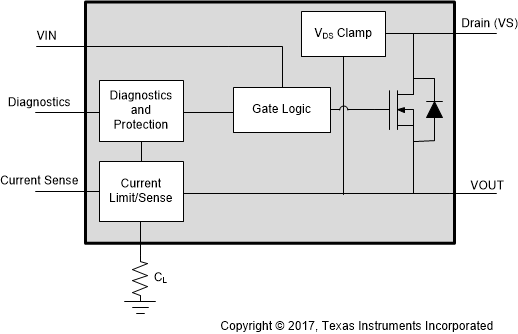SLVA927A November 2017 – April 2019 LM25066A , LM25066I , LM5050-1 , LM5051 , LM5064 , LM5066 , LM5067 , LM5069 , LM66100 , LM74500-Q1 , LM74700-Q1 , TPL7407LA , TPS1H100-Q1 , TPS1HA08-Q1 , TPS2113A , TPS2115A , TPS22810 , TPS22915 , TPS22916 , TPS22918 , TPS22971 , TPS22990 , TPS23525 , TPS2412 , TPS24751 , TPS24770 , TPS25942A , TPS2595 , TPS2660 , TPS27S100 , TPS2H160-Q1 , TPS4H160-Q1 , ULN2003A
6 Smart High-Side Switches
 Figure 7. Smart High-side Switch Block Diagram
Figure 7. Smart High-side Switch Block Diagram Smart high-side switches reliably drive off-board loads. These switches contain highly-adjustable and selectable current limits that enable a system to be optimally designed for specific loads. By connecting an external resistor to set the current-limit threshold, the switch protects the load and power supply from overstressing during short-circuits to GND events or power-up conditions. This enables more reliable designs by minimizing transient currents and supply droops. When the threshold is reached, a closed loop activates and clamps the output current to the set value. A fault is then reported on the CS pin.
These switches also offer highly-accurate current sensing to provide real-time diagnostics to the system. A current mirror sources current from VIN, reflecting this as voltage on the Current Sense (CS) pin. The CS pin does not need to be calibrated, and can serve as a diagnostics report pin. Whenever an open load or short happens, the voltage on the CS pin falls to 0 V. Whenever a current limit, thermal event, or an open load or short in the off state occurs, the voltage is pulled up to its maximum threshold. High-accuracy current monitoring and adjustable current limit are ideal for industrial applications like programmable logic controllers, motor valves, servo drives, and control units.
Another functionality of smart high-side switches is load-dump compatibility, which allows these devices to connect directly to a 12-V battery without concerns about typical voltage and current transients. Additional protection includes mitigation of large inrush current events that would otherwise damage downstream components.
Smart high-side switches can be AEC-Q100 certified, allowing full integration into many automotive applications that require a low on-resistance and high voltage tolerances to accommodate voltage spikes and inrush current events. Some of these applications include front and rear lighting, seat heating, infotainment, cluster, powertrain, and ADAS.
Table 7. Smart High-Side Examples (1)(2)
| DESCRIPTION | DEVICE | RECOMMENDED VOLTAGE RANGE | CURRENT SENSE ACCURACY | CONTINUOUS LOAD CURRENT | TYPICAL Ron | PACKAGE |
|---|---|---|---|---|---|---|
| Selectable current limit for design flexibility, low RON, small footprint, thermal sensing | TPS1HA08-Q1 | 3 V to 40 V | ±5% at 1 A | 0 A to 12 A | 8 mΩ | SOP |
| Low standby current, highly accurate current sense, thermal shutdown | TPS1H100-Q1 | 3.5 V to 40 V | ±3% at 1 A | 0 A to 4 A | 100 mΩ | SOP |
| TPS27S100 | 3.5 V to 40 V | ±3% at 1 A | 0 A to 4 A | 80 mΩ | SOP | |
| Multi-channel support, fast hardware interrupts, low standby current, loss of GND diagnostics | TPSxH160-Q1 | 3.4 V to 40 V | ±3% at 1 A | 0 A to 1.8 A per channel | 160 mΩ | SOP |
| Dual-channel, programmable current limit | TPS2HB08-Q1 | 3 V to 28 V | +3/-8% at 1 A | 0 A to 8 A per channel | 8 mΩ | SOP |
| Inductive load negative clamp with optimized slew rate, global fault report | TPSxH000-Q1 | 3.4 V to 40 V | - | 0 A to 1A | 1 Ω | SOP |
| Highly accurate current limit, supports full diagnostics with the digital status output | TPS1H200-Q1 | 3.4 V to 40 V | - | 0 A to 2.5 A | 200 mΩ | SOP |